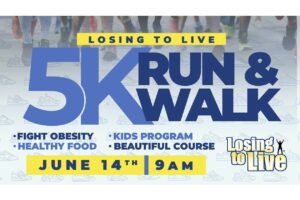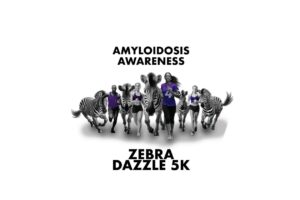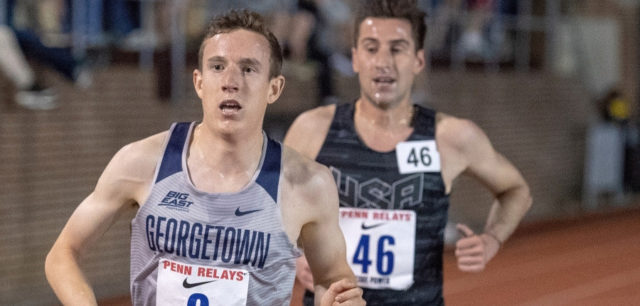
As a freshman at Georgetown, Mike Crozier didn’t see himself leading the workouts and trying to make a name for himself.
He wanted to show up, shut up and be patient.
“Just give myself time and work my way up,” he said.
He did that, but it took longer than he planned. Robbed of more than two years by persistent injuries, Crozier is about to finish his sixth year on the team in the grandest way possible – on the track at the NCAA championships, running the 10,000 meters Wednesday night in Eugene, Ore. His race is scheduled for 10:08 Eastern.
Based on his medical hardship, the NCAA awarded him a sixth year of eligibility for track. He used his extra time to earn a master’s degree in public policy.
Though a hockey player in his youth in Arlington, his steeplechaser father suggested he try out cross country when he started his freshman year at Gonzaga. A way to make friends at his new school. His first practice in the summer of 2018 was a loop around the National Mall.
“What better way to get a kid sold on the sport,” Crozier said. “I’ve seen the monuments hundreds of times, but this was different.”
So was the next morning. He was so sore he couldn’t walk without pain. And he loved it.
NCAA Track and Field Championships
June 6-9, 2018
Eugene, Ore.
Watch the races on various ESPN channels
Who’s running?
From Chantilly High School:
Sean McGorty – Stanford – 5k
From George Mason:
Sarah Moore – 400m – Blake High School
From Georgetown:
Amos Bartelsmeyer – 1,500 m
Nicholas Wareham – 1,500 m
Jonathan Green – 10k
Mike Crozier – 10k
From Good Counsel HS:
Rachel Pocratsky – Virginia Tech – 1,500 m
From Heritage HS:
Weini Kelati – New Mexico – 5k
From Lake Braddock Secondary:
Katy Kunc – Kentucky – 3k steeplechase
From Northwest HS:
Deigo Zarate- Virginia Tech – 1,500 m
From Heritage HS
Weini Kelati – New Mexico – 5k
From West Springfield HS
Caroline Alcorta – North Carolina – 10k
From Westfield HS
Sara Freix – Virginia Tech – 10k
“I thought, ‘this is cool, this is badass,'” he said. “I didn’t know a five mile run could kill someone.”
Upperclassmen Billy Ledder and Collin Leibold encouraged Crozier to do what it took to contribute to the varsity team, teaching him how to be a serious runner.
“We also had some fun, too,” he said. “When you have 60 or 70 guys on the team, they aren’t always all as focused but they still have a lot to contribute to the team atmosphere. Coach (John) Ausema appreciated that and kept a good environment on the team.”
With Leibold and Ledder at college, Ausema said Crozier’s senior year took some creativity, but his work ethic and tricks like having him chase down other runners during workouts helped prepare him for a 13th place finish at Nike Cross Nationals. That opened the door to scholarship money from Georgetown.
Not so fast
After recovering from some growth spurt injuries, Crozier adjusted to his collegiate program. He ran a sub-25-minute 8k as an unattached runner for his first race, but soon after he started feeling worn down.
“It was a great start for a freshman,” said Georgetown distance coach Brandon Bonsey. “He showed a flash of what he was capable of.”
The mystery ailment kept him in the pool and on the bike throughout the rest of his first year. As summer approached, more testing found the answer.
A hernia. A stress reaction in his public bone. His rectus abdominis had torn away from his pelvis. One of his hip adductors had torn away from public bone. Surgery in July 2013 would take care of all of that.
Crozier was alternating walking and jogging by November, and got back to a light training load by the end of the year. Then in March, on his way to more cross training in the Yates Field House, he slipped on some icy steps and landed on his hip.
“I knew in a second it wasn’t good,” he said. “I re-fractured it. It was going to be eight more weeks of no running and two more cortisone shots.”
By the end of his second year, Crozier had one college race to his name.
“It was frustrating for him, he spent more time in the Yates field house cross training than anyone in Georgetown history,” Bonsey said. “He was gun shy for about a year after that, which is understandable when you’ve dealt with such a long injury.”
After his sophomore year, Crozier went for a walk on the C&O Canal Towpath and had to lift his leg over a fallen tree branch. When he did, he felt no pain. For a guy who spent two years limping up stairs, it was a big step in the right direction.
“I missed so much training when I was 18 and 19, which a really critical time if you’re hoping to be good when you’re 21 and 22,” he said. “When I came back, I needed to balance my expectations versus reality, because times I was hoping to run by now might not come so easily.”
It took until Crozier’s fourth year before he looked like the runner who showed up in shape in 2012. With his time in undergrad coming to a close, Crozier asked Bonsey what it would take to keep him on the team longer. The answer was an NCAA qualifier in the 10k, which meant running under 29:40.
“I got a great night at the Penn Relays – we came through 5k in 14:55, it felt easy – and closed in 29:32,” he said. His first trip to the NCAA first round and a ticket to two more years of track. It was the first race where he really put pressure on himself – the NCAA time was a major inducement, and he performed well.
“That’s when he really started to get back to where we thought he’d be, before the injury,” Bonsey said.
His advice to Crozier was simple – consistency and focus.
“He told me to live every day like the elite athlete I wanted to be,” Crozier said. “Live like you’re going to race NCAAs next week even if you won’t qualify for Big East. And that was important to me – I wanted to perform on the track, not just be ‘good locker room guy’ because I stuck with it through all the injuries.”
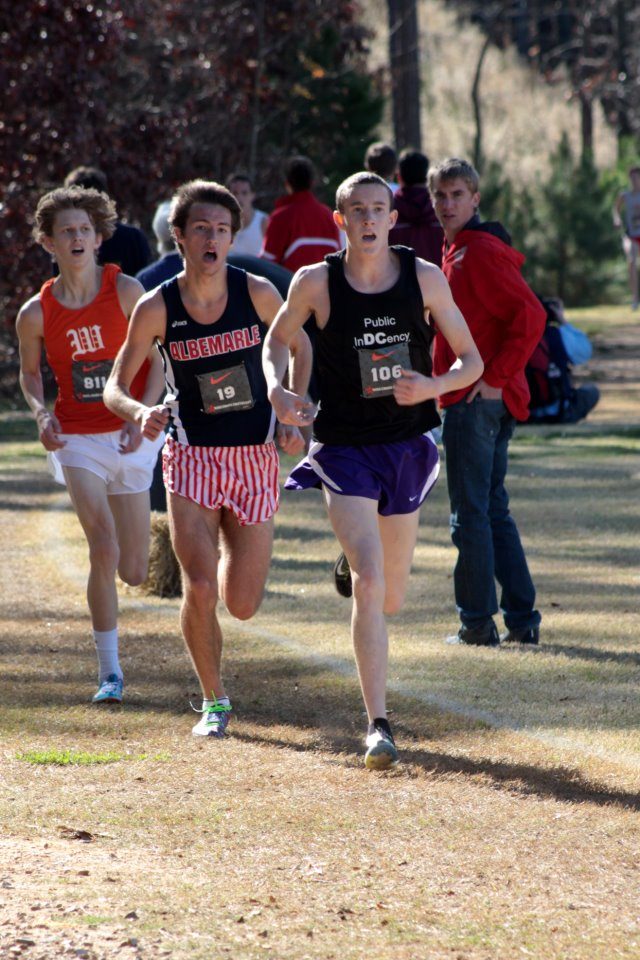
Training to hold a stopwatch
He was still seen a little differently, though. By his sixth year, he was 24, compared to 18-year-old freshmen.
“It’s a huge age gap,” Crozier said. “Some of the guys look at me as more of a coach than a teammate because I’m so old and I’ve been around the block.”
Some athletes treat him like a liaison to the coaching staff, and he is able to fall back on his experiences to help his teammates.
“He’s been good with pulling guys aside when they’re having trouble and working them through that,” Bonsey said. “He’s probably had more frustrations than any of them. He figures out ways to motivate them.”
It’s helped Crozier land on getting into coaching formally, which he will next year as a volunteer assistant coach at Georgetown. But for all the help he’s provided, Bonsey doesn’t want him growing up too fast.
“There are times I’ve had to hold him back, had him focus on his own running first,” he said. “There’s plenty of time after the season for that.”
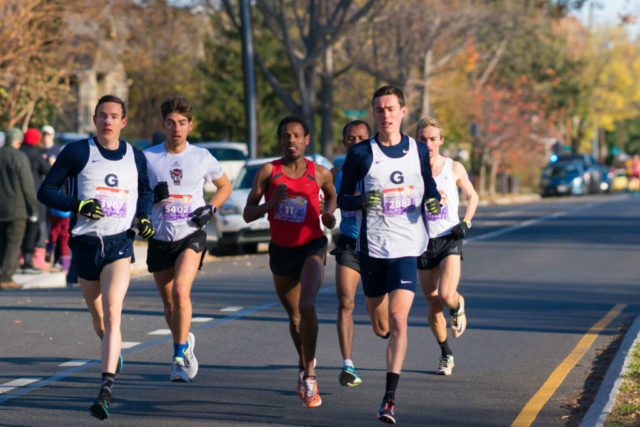
Saving the best for last
Before Crozier coaches, there’s the matter of his 10,000 meter race at nationals. After lowering his best time to 29:14 at the Stanford Invitational, he had his hopes high for making the NCAA final. The first round of the championships were held in sweltering Tampa two weeks ago, where the heat and humidity could take a lot out of the runners over the course of 30-plus minutes. It was Crozier’s third try at the race and he aimed to hang with the top 10 runners, with the top 12 advancing.
Water stops along the back stretch offered a respite from the air, which was in the upper 70s even at 10:30 p.m.
“Usually it starts out really slow and in the second half people start goinghard,” he said. “This time it went out at an honest pace – 14:57 for 5k, and even when we sped up six kilometers in, the 68s, the 69s felt easy.”
Then his foot was clipped, and he woke up to a race that suddenly felt a lot harder.
“I took a lap to drop back and feel things out,” but he was still in the top 13 or 14.
With 600 meters left, he pulled up along Virginia Tech’s Peter Seufer, who was breathing heavily with 350 meters to go and holding onto 12th place. Half a lap and a massive surge later, Crozier’s double-take showed Seufer was nowhere to be found.
He crossed the finish line and fell to the ground, laughing.
“I made it much more dramatic than I needed to but coaches were watching,” he said. “They waited long enough, so I gave them a show.”
After five minutes to be “super stoked,” he was back to business and focused on Eugene, where he will close out his career days before historic Hayward Field is demolished.
“I try to stay even keeled,” he said. “Never too high, never too low. I know what I’m doing every day, and it doesn’t matter if I’ll be an All-American on Wednesday or 24th, I know I’m going to get up the next day and run.”
Knowing himself
Ten years into his competitive running career, Crozier has a good feel for what has needed to improve. Two years of cross training bolstered his aerobic capacity, which ended up being his recipe for success even when he came back.
“I had a lot of time to figure it out,” he said. “I can do 90-100 miles a week, but I can’t handle a lot of intense track sessions.”
He’s particularly fond of long slogs, including two four-mile workouts minute apart. Starting at the bottom of the Custis Trail near the Key Bridge, he alternated 90 seconds hard, 30 seconds moderate to run 20:50 for the first segment. He recovered briefly,jogging from the Quincy Street exit and finished with four miles on the Washington-Lee High School track, starting at 5:00 mile pace and picking it up until he finished in 4:50.
As the season comes to a close, Crozier is also looking forward to taking time away from competition after NCAAs and having a beer while in Oregon.
“I haven’t had one since my friend’s wedding in July,” he said. “I go ‘full monk’ when I’m training.”
It’s the kind of focus that has taken a two-year-long injury case to the highest level of collegiate competition. He’ll ease up and take a break from competition after NCAAs.
“Mike knows himself and he’s a student of the sport (including 10 years working the sales floor at Pacers) and I give him a lot of autonomy,” Bonsey said. “He runs higher mileage than anyone but he knows what his body can handle.”
Bonsey had Crozier independently write a week of his training leading up to the NCAA meet, and the results were stunningly close to what his coach cooked up.
“I think he has a bright future in coaching if this is what he plans to do,” Bonsey said.
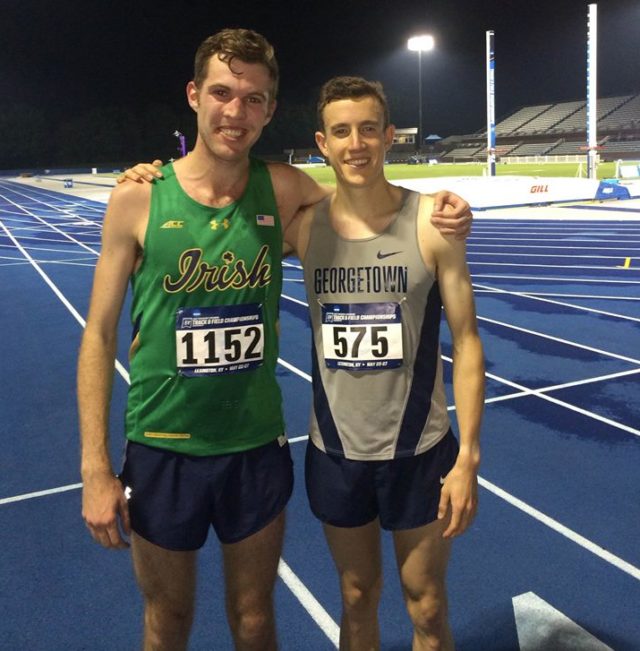
Recent Stories
Looking for our race calendar? Click here Submit races here or shop local for running gear
Losing to Live 5K Run & Walk
WHEN Saturday, June 14, 2025 at 9:00 am WHERE This convenient location is just minutes from your house located 1/2 mile inside the 1-495 Capital Beltway at exit 51. Spectators are welcome to watch and cheer on the runners. Capital
Zebra Dazzle 5k Walk/Run or 100 Bike over 30 Days
Join the Zebras for this Zebra Dazzle event for all fitness levels. The 5k Walk/Run has 2 options. You can participate as an onsite participant on 9/13 at Carter Barron in Rock Creek Park, NW Washington DC or as a





